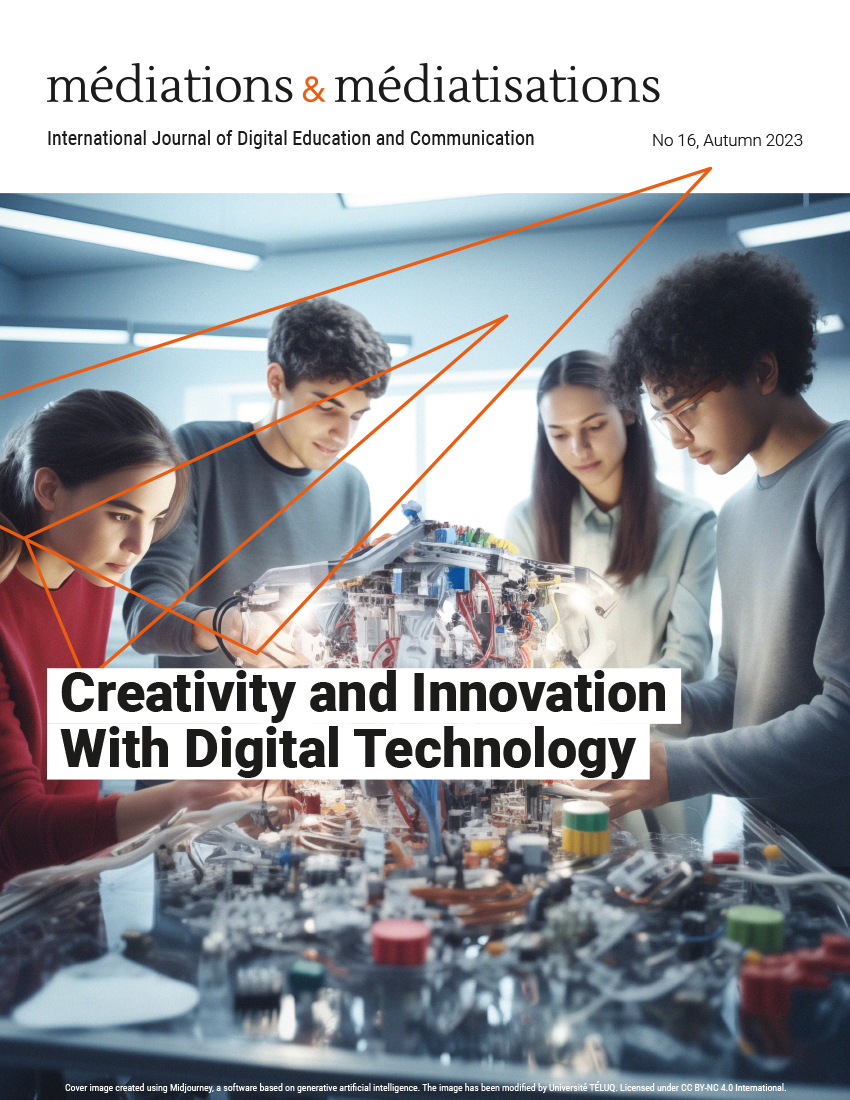Creative Spaces to Support Digital Competence: Challenges of the “Creative Technologies and Networked Learning in Education” University Course
Main Article Content
Abstract
To train future teachers, a university course has been developed that allows students to address dimensions of digital competence that were previously absent from their training. The course focuses on the place and possibilities of creative laboratories in a school context. The course addresses pedagogical innovation and creativity through its reflective and practical aspects. The article relates initiatives to place creative labs, their tools or ways of doing things, at the heart of the course activity. One of the issues quickly revealed by the initiation was linking a creative space and informal learning to the formal context of a university program.
Downloads
Article Details
References
Blikstein, P., et Krannich, D. (2013, juin). The makers’ movement and FabLabs in education: experiences, technologies, and research. Dans Proceedings of the 12th international conference on interaction design and children (p. 613-616). https://doi.org/10.1145/2485760.2485884
Blikstein, P. (2013). Digital fabrication and ‘making’ in education: The democratization of invention. Dans J. Walter- Herrmann et C. Bόching (dir.), FabLabs: Of machines, makers and inventors (p. 203-222). Transcript Publishers.
Brown, M., McCormack, M., Reeves, J., Brook, D. C., Grajek, S., Alexander, B., Bali, M, Bulger, S., Dark, S, Engelbert, N., Gannon, K., Gauthier, A., Gibson. D. Gibson. R., Lundin, B., Veletsianos, G. et Weber, N. (2020). 2020 Educause Horizon Report. Teaching and Learning Edition (p. 2-58). Educause. https://library.educause.edu/resources/2020/3/2020-educause-horizon-report-teaching-and-learning-edition
Davidson, A.-L. et Duponsel, N. (2021). Building a makerspace in a youth center and imagining futures. 2021 IEEE International Symposium on Technology and Society (ISTAS), p. 1-7. https://doi.org/10.1109/ISTAS52410.2021.9629131
Deschênes, M. et Parent, S. (2022). Vers une définition de l’agentivité du personnel enseignant : une revue systématique de la littérature. Revue des sciences de l’éducation, 48(3), 1-19. https://doi.org/10.7202/1103273ar
Giroux, P., Monney, N., Pépin, A., Brassard, I., et Savard, V. (2020). Laboratoires créatifs en milieux scolaires : état des lieux, stratégies pédagogiques et compétences. Université de Chicoutimi. https://constellation.uqac.ca/id/eprint/6191
Halverson, E. R., et Sheridan, K. (2014). The maker movement in education. Harvard educational review, 84(4), 495-504. https://doi.org/10.17763/haer.84.4.34j1g68140382063
Hatch, M. (2014). The maker movement manifesto: Rules for innovation in the new world of crafters, hackers, and tinkerers. McGraw-Hill Education
Hira, A., Joslyn, C. H., et Hynes, M. M. (2014, octobre). Classroom makerspaces: Identifying the opportunities and challenges. 1677–1681. Dans 2014 IEEE Frontiers in Education Conference (FIE) Proceedings. https://doi.org/10.1109/FIE.2014.7044263
Makerspaces.com. (s.d.). What is a makerspace? Makerspace. https://www.makerspaces.com/what-is-a-makerspace
Ministère de l’Éducation et de l’Enseignement supérieur. (2019). Cadre de référence de la compétence numérique. Gouvernement du Québec. http://www.education.gouv.qc.ca/fileadmin/site_web/documents/ministere/Cadre-reference-competence-num.pdf
Ministère de l’Éducation et de l’Enseignement supérieur. (2018). Plan d’action numérique en éducation et en enseignement supérieur. Gouvernement du Québec. http://www.education.gouv.qc.ca/fileadmin/site_web/documents/ministere/PAN_Plan_action_VF.pdf
Oldenburg, R. (1999). The great good place: Cafes, coffee shops, bookstores, bars, hair salons, and other hangouts at the heart of a community. Marlowe.
Parent, S. et Lord. A. (2022, 11-12 mai). Concertation régionale sur les consensus et tensions liées aux apprentissages dans les espaces créatifs [Communication orale]. Dans Joncoux, S., Baril, G., Scaillerez, A., Lafontaine, D., Guimont, D. et Davidson, A.-L., Colloque 637 : Laboratoires vivants et autres labs, des outils pour les transitions [Symposium]. Acfas. Québec (Canada). https://monurl.ca/acfas2022parent
Parent, S., Michaud, O, Davidson, A-L., Sanabria, J., et Artemova, I. (2022). Apprentissage non formel dans quatre espaces créatifs québécois : analyse basée sur la théorie de l’activité. Revue internationale du CRIRES : Innover dans la tradition de Vygotsky / CRI_SAS international Journal : Vygotsky's Heritage: Innovation in Education, 6(3), 66-85. https://doi.org/10.51657/ric.v6i2.51549
Parent, S., Gicquel, A, Mercure, J-F, et Laflamme, V. (2022). Projet Premiers peuples : un contexte authentique, multidisciplinaire… et numérique! École branchée, 25(1), 10-11.
Tremblay, D. G., et Krauss, G. (2019). Tiers-lieux : Travailler et entreprendre sur les territoires : espaces de co-working, fab labs, hack labs… PUQ.
Trust, T., Maloy, R. W., et Edwards, S. (2018). Learning through making: Emerging and expanding designs for college classes. TechTrends, 62, 19-28. https://doi.org/10.1007/s11528-017-0214-0

